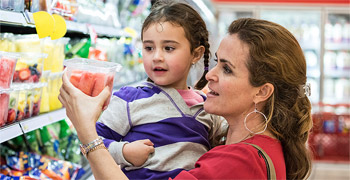Reading Food Labels

Reading Food Labels
Trying to understand food labels can be pretty daunting. It's easy to feel overwhelmed by all the information you see on packets, jars and cans in the supermarket. Thankfully, there are a few key pieces of information that can help you to quickly make healthy and informed choices.
Nutrition content claims – what's allowed?
The first thing to remember is that food manufacturers want you to buy their products. They invest huge amounts of time and money in marketing their brands. A 'fat free" product may have no fat, but be packed with sugar to make it more enticing to eat. A 'sugar-free" product may not be that sweet, but be packed with fats to boost the flavour.
Jean Hailes dietitian Anna Waldron advises caution around these types of claims on labels. 'It's easy to be tricked into thinking a food product is healthy when it isn't," says Anna. 'It's a good idea to also check the ingredients list and nutrition information panel to see what's in the product. The saturated fat, fibre, sugar and sodium content can all be important to consider. Some people with special dietary considerations may need to look for other information on the label too."
There are regulations (Food Standards Code) in Australia that cover all aspects of the sale of food including the labelling of food products. Claims can only be made if the product meets certain criteria.
Nutrition content claims – what they really mean
Fat free – the product must contain less than 0.15% fat
Low fat – must contain less than 3% fat for a solid food or 1.5% for liquids
Reduced salt or reduced fat – this must have at least a 25% reduction compared to the original product
Good source of iron/calcium/protein claims – these must contain no less than 25% of the daily recommended intake (RDI) of the listed mineral or vitamin in a serve
No added sugar – a product stating no added sugar may still have a high sugar content from natural sources of sugar such as fruit
Cholesterol free or no cholesterol – dietary cholesterol is mostly found in animal products such as prawns, meat and eggs. This claim means nothing in a plant-based product, as plant foods contain virtually zero cholesterol anyway. A cholesterol-free product may be high in saturated fat which contributes to increasing our blood cholesterol level. It is more important to check the saturated fat content if you are trying to lower your cholesterol
While food packaging is designed to make the product appear more enticing, the nutritional contents and ingredients list is what really matters.
Nutritional information panel
The nutritional information panel is found on most packaged foods and gives you the exact quantity of nutrients including the energy content in kilojoules, protein, total and saturated fat, carbohydrate, sugars and sodium. There are often two columns of numbers – quantity per serving and quantity per 100g (or 100ml). When you are comparing products it is easier to use the quantity per 100g column as serving sizes may differ between products.
To help you try to choose the healthiest options, look out for the recommended nutrient levels listed below. These are just general guidelines and there are exceptions to these rules with certain foods.
Saturated fat – aim for less than 3g per 100g (exceptions may include cheese, seeds, nuts, oils and margarines)
Total fat – aim for less than 10g per 100g (exceptions may include nuts, fish, seeds and other sources of healthy fats)
Sugar – aim for less than 15g per 100g
The ingredients list
Ingredients are listed in descending order. This means the first ingredient listed is the one with the largest quantity in the product, while the one with the smallest quantity is listed last. If sugar is listed near the start of the list, you can be sure that the product contains a high proportion of sugar.
Health star rating
Australia's health star rating (HSR) helps you to make healthier choices when buying packaged foods. Launched in July 2015, the HSR system aims to take the guesswork out of deciding how healthy (or not) a product is. The healthier a food is, the higher the star rating, with numbers ranging from ½ star for less healthy to five stars for the healthiest choices. The HSR is displayed on the front of packaged foods, to give an at-a-glance summary of the nutritional profile. However, the HSR is a voluntary system, so unfortunately not all food manufacturers have adopted it.
On the HSR label, the nutrient content such as energy, saturated fats, sugars and sodium may also be shown. The label may also highlight one positive nutrient such as protein, fibre or certain vitamins and minerals. The HSR can make it easier to quickly compare two similar products, for example breakfast cereals. They may appear to be fairly similar but the HSR of one could have a rating of three, while the other could have a rating of five, indicating the healthier option, without having to read the nutritional information panel.
'Eating well for your health isn't meant to be complicated," says Anna. 'Remember, the foods without labels, such as fruit and vegetables and non-packaged foods, are often some of the better choices to make."
Learn more about good nutrition and healthy food choices on the Jean Hailes website.
Published with the permission of Jean Hailes for Women's Health
jeanhailes.org.au
1800 JEAN HAILES (532 642)
MORE



